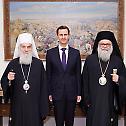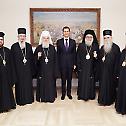The Third Day of Patriarch’s visit to the Patriarchate of Antioch
Syria is full of ruins that “tell” stories of the Holy Scriptures, where it is mentioned for 300 times, and where Aramaic language was born and preserved, the language spoken by Lord Jesus Christ. (photo gallery 1, photo gallery 2)
The President of Syria Mr. Bashar al-Assad received His Holiness Irinej, Serbian Patriarch, with two members of his dlegation: Metropolitan Amfilohije of Montenegro and the Littoral and Bishop Jovan of Sumadija, in the presence of His Beatitude Patriarch John of Antioch and All East, in Damascus, on 3 June 2019.
President Assad pointed out that what both Syria and Serbia have been exposed, in terms of foreign interference and attempts to undermine their sovereignty and social tissue, as well as persistence of the peoples of the two countries in facing such attempts, represents a solid basis for promoting a national dialogue and co-operation for long-term relationships serving the interests of both poples.
The Serbian Patriarch Irinej expressed his confidence in the ability of Syria to overcome the circumstances of life through which it goes and to restore its historical role of an efficient state while establishing stability and spreading peace and love in the region. His Holiness emphasized that determination and persistence of the Syrian people in maintaining the unity while facing terrorism, of which he also became a witness during this visit, have strengthen this confidence. Patriarch Irinej highly evaluated the principle-oriented and unwavering support of President Bashar al-Assad for Serbia in relation to Kosovo and Меtohija.
President Asad, in turn, expressed his respect for the deep human stance of Patriarch Irinej in promoting the values of love and the rejection of extremism.
Visit to Sacred Thecla monastery
At 10 o’clock of the same day, 3rd June 2019, the Serbian Church delegation with His Beatitude John and his hierarchs, guests and the entourage visited a great sacred place - the monastery of Saint Tecla. A convoy of eleven cars, accompanied by a strong police escort, immediately after leaving the city of Damascus faced with a terrible sight on both sides of the highway. Not only settlements, but entire cities were leveled with the land. The whirlwind of the war and the hatred of men slammed everything in front of them. There was no mercy to any one object, not even to religious ones. On both sides of the road we occasionally encountered clouds of smoke in the distance, the so-called mushrooms.
There are quite a lot of Christians in Syria. According to official data, about 10% of Christians live in this country: Orthodox Arabs, belonging to the Antiochian Patriarchate; Jacobites, Nestorians, Armenians of the Gregorian Church and Armenian Catholics. They all have their monuments and churches in Syria of which many are damaged now.
The sacred Thecla Monastery suffered also during the conflict. The worst situation happened to this monastery in the town of Maaloula, nearby the Lebanese border. Namely, “Islamic State” attacked the small town of Maaloula on 5 September 2013 and launched an attack on Christians and buildings, destroying all sacred places in the town. Three thousand people left the town, leaving only Moslems and 40 nuns of this monastery, out of whom twelve were kidnapped by IS at the beginning of the same year. Nuns were liberated in March 2014. This action was enough for the Christian world to understand that the religious war began. This is why Christians unanimously support the Assad government, realizing that if the opposition came to power, and in particular the radical Islamists, they and their cultural monuments would be exterminated first. To indicate, the sacred Thecla Monastery is on the UNESCO World Heritage List.
And this time, and according to the custom of this country, the welcome was emotional. Hundreds of smiling and cheering men, women and children shouted joyful tones. Despite the great heat (over 40 degrees), a great crowd of people were devoutly approaching and kissing the holy right-hand of Patriarch Irinej. Soon afterwards, one of the men sang a short hymn of praise and welcome to the Serbian Patriarch.
After the doxology to Patriarch Irinej, the spiritual father of the monastery, Archimandrite Elias Ades, greeted the primate of the Serbian Church with his welcoming address.
After a tour around the monastery complex and a talk with the people, Patriarch Irinej spent some time in prayer in the cave of Saint Thecla.
In the monastery of the Most Holy Mother of God in Sidnaya
The monastery is dedicated to the Most Holy Mother of God. It was founded in 547 and it is located 30 km north of Damascus. It suffered a significant damage in recent years due to terrorist attacks. There are about forty nuns living in the monastery, who at the same time take care of an orphanage that is located within the monastery walls. The monastery was built by Emperor Justinian in the 6th century. It preserves a miraculous icon of the Most Holy Mother of God of Sidnaya, which, according to a tradition, was painted by Holy Apostle Luke.
Serbian Patriarch Irinej was welcomed by many people. A que of girls from the orphanage with flowers in their hands waved to the Patriarchs. Younger children held flags of Serbia and Syria. Sounds of the trumpet and drumming orchestra were heard in the background. At the doxology rite the abbess of the monastgery addressed the SerbianPatriarch.
This day was ended with a visit to the Embassy of the Republic of Serbian in Damascus. Patriarch Irinej and the delegation of the Serbian Orthodox Church, along with Patriarch John and His entourage, was welcomed by His Excellency Milan Vijatovic, Ambassador of the Republic of Serbia in Syria.
A visit of the monastery of Saint Belman in Tartous province at the Syrian coast, as well as of the monastery of Saint George in the Valley of Christians near Homs, the oldest Christian monastery in the west of Syria, built in 4th century, was scheduled on Tuesday, 4 June 2019.





